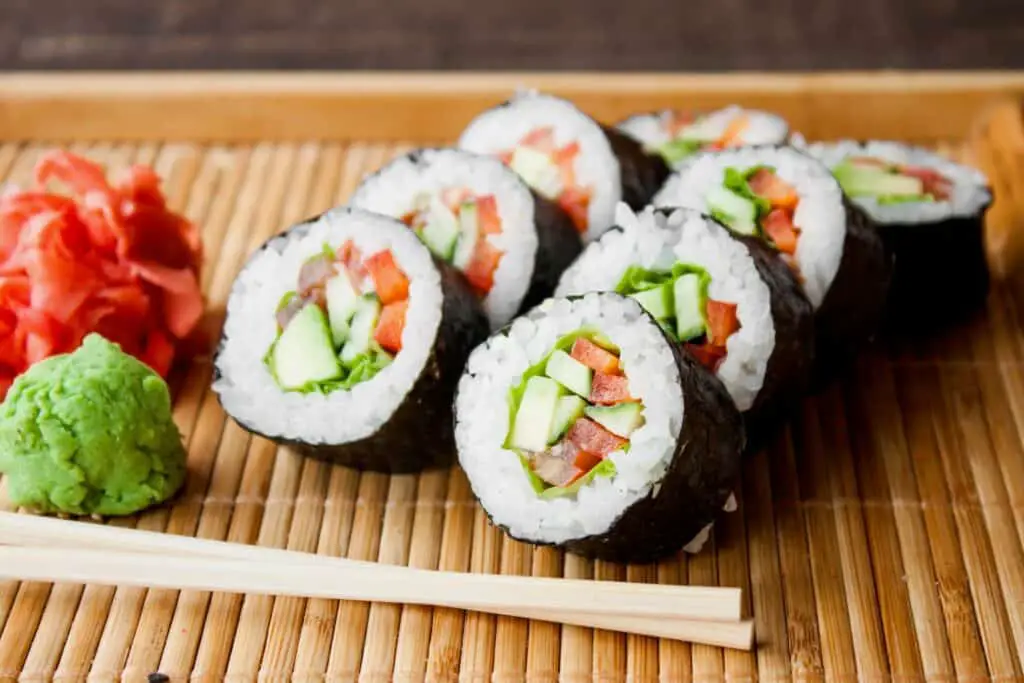Soy is an integral part of traditional Japanese cuisine. With sushi being an iconic Japanese dish, many people wonder – Does sushi have soy?
No, you won’t find soy in most sushi dishes, except for those made with tofu, such as Inarizushi or some veggie sushi rolls. However, sushi is usually consumed with soy sauce, which is, naturally, high in soy. If your diet shouldn’t contain it, choose coconut aminos sauce as the best alternative to soy sauce.


There is a lot to learn about soy and sushi combinations. If you’re interested in it, the following article will help you discover everything you want to know.
No, Sushi Usually Does Not Have Soy but Is Often Served With Soy Sauce
Although sushi ingredients vary depending on the sushi type, not many of them include soy. Rather than that, raw fish, seasoned rice, vegetables, and seaweed are the ingredients sushi is known for. However, this Asian dish is usually served with soy sauce aside, which is, as the name suggests, made of soybeans.
Still, there are restaurants where sushi comes with a bit of soya sauce already on it. It’s not common practice, especially in the States. However, if you can’t eat it because of your health issues, ensure you ask the staff about it before booking your reservation.
When Should You Avoid Eating Soybeans?
Although some research shows that soy can decrease the risk of cancer and heart problems, it’s not food that everyone should overeat. If you have a thyroid problem for which you take medication, for example, you may want to watch your soy intake – studies show that soy can interfere with the absorption of the medicine. Other studies concluded that soy could also negatively affect ovarian function and digestion.
Of course, there are also people who are allergic to soy. Usual symptoms include swelling of the tongue and lips, tingling sensation in the mouth, and skin eczema. If you had some of these, you should eat only soy-free food.

Curious to know more about other Japanese delicacies? Read also :
Is Nigiri Sushi?
Can You Eat Sushi The Next Day?
What Is Tobiko?
Where To Buy Sashimi?
Is Sashimi Tuna?
Inari Sushi Is One Sushi Type That Contains Soy
Inari sushi (or inarizushi) holds little similarity to sushi types you’re probably familiar with. It’s made of vinegared rice placed inside little tofu pockets – and tofu, as you probably know it, is made of boiled soybeans.
Since inarizushi doesn’t contain fish, it’s vegan-friendly. Moreover, it is one of the easiest sushi types to make at home. It can be an excellent sushi choice if you’re looking for the type that does not contain soy.
The story of its origin is fascinating, as well. The name Inari originates from the Japanese god of agriculture. These deep-fried tofu pockets (aburaage) were brought to his shrines as a gift and placed in front of fox statues – it was believed that foxes are Inari’s messengers, and they like aburaage. Later on, rice was also added to the aburaage as a token of great gratitude.
There is Tokio-style and Osaka-style inarizushi. The First one is bag-shaped, with aburaage completely covering the rice. On the other hand, Osaka-style is more similar to sushi that we are all used to. It’s straw-bagged or triangle-shaped, with an open-top. While rice covers the bottom of each piece, other ingredients can be added on top of it.
Vegan Sushi Can Have Tofu as an Ingredient, as Well
Vegans as well those who don’t particularly like the taste of raw fish often opt for vegan sushi rolls. In some of them, chefs use tofu as a substitute for meat. Combined with avocados, mushrooms, carrots, cucumbers, asparagus, and onion, these rolls can represent a truly healthy meal.
If you’re on a soy-free diet, there is still a way of making delicious veggie rolls – all you have to do is use tempeh instead of tofu. Although tempeh is also usually made from soy, there are other types, such as those made from yellow peas. Take a look at the table below to compare its nutritive elements with the ones you get with tofu.
| Nutrition elements (per ounce) | Yellow Pea Tempeh | Firm Tofu |
| Calories | 64 Cal | 23 Cal |
| Crabs | 10 g | 0 g |
| Fat | 0 g | 1 g |
| Protein | 4 g | 2 g |
| Fiber | 4 g | 0 g |
| Calcium | 0% | 3% od daily value |
| Iron | 5% of daily value | 2% of daily value |
What Are Soy Sauce Ingredients?
Even if there is no soy in a sushi dish, it will most likely be served with soy sauce. Soy sauce has only four basic components:
- Soybeans,
- Salt,
- Water,
- Wheat.
In the process of making soy sauce, soybeans are soaked in water, and wheat is roasted and crushed. Then, soybeans and wheat are mixed with Aspergillus (culturing mold) and left for two or three days. After that period, water and salt are added, and the whole mixture is left to ferment for around five to eight months. After that time, it is bottled and ready to use.
Fish, Seaweed, Rice – Which Part Should You Dip Into the Sauce?
Believe it or not, most people make a mistake when dipping their roll or nigiri into soy sauce. According to sushi chefs, when eating a nigiri, you should never dip the rice part of a dish – in nigiri, rice is not strongly squeezed, so it will absorb quickly and, oftentimes, too much sauce. Instead, dip the fish side into the sauce.
The same goes with seaweed in maki rolls – instead of dipping the rice part, always choose the part that is covered with nori.
Is Soy Sauce Safe to Eat if You’re on a Gluten-Free Diet?
While soy itself is gluten-free, wheat, a standard soy sauce ingredient, is not. Therefore, if you’re on a gluten-free diet, you have two choices – you can either make your own gluten-free sauce, buy one, or ask for a suitable substitute in the restaurant, such as coconut aminos.
Coconut aminos sauce tastes very similar to soy, only a little bit sweeter. It is made from aging coconut blossoms and is not as rich in nutrition as soy sauce. However, it’s an excellent substitute for those who have problems eating soy or wheat.

It’s Never a Wrong Time for Sushi
There is a reason sushi is one of the favorite dishes around the world – it’s just that flavorful. However, even if you can’t eat standard sushi dishes because of health or personal preferences, find a restaurant that offers sushi you can enjoy. The same goes with soy sauce! Do not deny your taste buds such deliciousness!